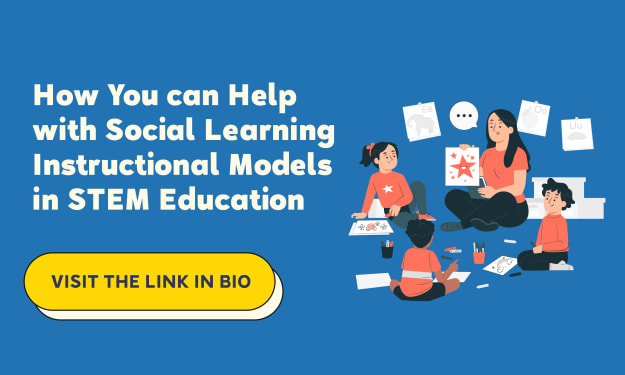Teach Your Kids the Systematic Way to Solve Problems in STEM Education
How good it would be if there were a readymade framework to help your kid solve problems.

Teach Your Kids the Systematic Way to Solve Problems in STEM Education
How good it would be if there were a readymade framework to help your kid solve problems. A systematic method, with continuous practice, will morph into a cognitive strategy that your child can use for a lifetime in STEM education, robotics for kids and coding for kids.
Systematic Approach to Problem-Solving
Adopting a specific method to solve problems is one of the most common approaches to problem-solving, especially among engineers and scientists. A systematic way is considered more scientific as it has a proven track record.
The analytical problem-solving method is often cited as the core of critical thinking.
It's more accurate when kids approach a subject analytically. It implies adopting and applying logic and reasoning. Their work is held to high standards, particularly in terms of logic, accuracy, and clarity, as the work is submitted to our thought process, and its conclusions to sufficiency tests using empirical data.
The Steps
This method of problem-solving is inductive. It is frequently employed in tasks that begin with a hypothesis, such as math and science. The systematic approach can be understood as a series of six typical steps.
This method can quickly become a cognitive technique for general and specific problem-solving with good practice.
1.Clarify and Understand the problem as much as you can.
2.Create criteria and take into account potential solutions.
3.Decide on the problem alternative with the best chance of success.
4.Put the chosen strategy to the test or use it.
5.Evaluate to assess how well the problem has been solved.
6.Check and validate that the alternative successfully resolves the issue.
(A) Clarify and Understand the problem as much as you can
Understanding the problem at hand is one of the most crucial elements in solving a problem. Although it might seem like a simple observation, persons who run into difficulties frequently make the error of misunderstanding the situation and jumping to conclusions. Many people are not adept at solving analytical problems and rush into them without research.
Posing the problem is complex, and understanding the nature of the problem is crucial to finding a solution. Empirical study has shown that posing a problem enhances students' understanding of the material and results in interest and motivation.
Problem posing includes asking the following questions to oneself: Do you comprehend every word, phrase, and idea used in the problem? Do you understand what you must be able to do or demonstrate? Do you believe you have all the information you need to solve the issue, or do you think you need more?
Kids must be sure they know the query or the problem that has to be solved. Before tackling the problem, your youngster should ask what the questions will be. Problem posing, a teaching strategy that enhances students' thinking, problem-solving abilities, attitudes, and confidence in mathematics, is one technique to educate your child about problem identification.
Encourage your child to ask questions that could help them understand the issue, such as the following
1.What is the root of the issue?
2.What is the issue?
3.What must be investigated to comprehend the issue?
4.Use a chart or an image as the basis for your problem.
5.Craft a scenario-based problem.
Your child won't be able to fix a problem if she doesn't comprehend it. If you are having difficulty solving a problem, you either don't grasp it or are approaching it incorrectly.
(B) Generate Potential Solutions
Your child should be able to come up with some solutions to the problem if she has been able to articulate or describe the nature of the issue and what is being requested.
Brainstorming is a method for coming up with potential answers to problems. The goal is to come up with as many possibilities as possible without placing too many restrictions on them.
This is typically a group problem-solving method that entails the spontaneous submission of ideas from all group members. Still, it may also be the careful consideration of ideas by one or more people to come up with or find a solution to a problem.
You can collaborate with your youngster while initially leading and directing the process.
© Decide on the problem alternative that has the best chance of success.
Your kid will have to determine which functions are necessary to create a solution to the questions when dealing with math problems.
You can frequently encourage and prompt your kid to recall instances or incidents from her memory and past that may assist her in comprehending how to resolve the problem.
The general rule is to prompt or elicit pertinent prior knowledge ("remember when…"); ask your child to explain, deduce, and forecast during reading ("think out loud…"); and stimulate your child's imagination.
(D) Put the chosen strategy to the test.
Once your kid has chosen the alternatives, the next step is to use the option they have determined to be the best to proceed with the process that will produce the desired outcome.
(E) Evaluate to assess how well the problem has been solved
Although applicable to less complicated situations, this is especially crucial for lengthy and intricate ones. For instance, the youngster would need to continuously assess progress toward a solution for math problems that may have several possible explanations.
Does the kid list every option that could be used to solve the problem? Does she use the proper mathematical operations? Are the findings true and correct? Is the child making enough time-related progress, i.e., does she take too much or too little time to tackle the issue?
(F) Check and validate that the alternative is successful in resolving the issue.
Your kid will inquire as to whether her answers are accurate. The child will be able to get fast confirmation from you if she is collaborating with you. If she completes her homework, she must bring her worksheets to school so the instructor can see them. The procedure of getting feedback from the teacher can frequently be drawn out.
Getting immediate feedback is helpful when learning new things. Early on, parents should offer confirmation, but you can also start teaching your child how to check their work.
The bottom line is that the systematic approach outperforms other non-scientific problem-solving methods, employing deliberate strategies to boost the likelihood of success. It is better than intuition since it is less likely to be influenced by bias and prejudice and has a lower failure rate.
This article was first published here:https://playcomputer.org/teach-your-kids-the-systematic-way-to-solve-problems-in-stem-education/
Play Computer (Pee Cee) is India's First Open Source Programmable Electronic Platform specially designed for kids. It is designed to promote STEM Education & Learning for Kids in a fun way.
With this pocket ninja, kids learn about Robotics, Coding, AI, and IoT through practical projects. Kids are not only learners but also become creators and problem solvers who are not afraid to test their creativity and try something new.
About the Creator
Enjoyed the story? Support the Creator.
Subscribe for free to receive all their stories in your feed. You could also pledge your support or give them a one-off tip, letting them know you appreciate their work.





Comments (1)
Teaching kids the systematic approach to problem-solving in STEM education is crucial for their cognitive development. The outlined steps, from understanding the problem to evaluating the chosen solution, form a structured framework that cultivates critical thinking. This method mirrors the structure of problem solution essays as mentioned in https://edubirdie.com/examples/problem-solution-essays/ where a clear identification of the issue, exploration of potential solutions, and evaluation of the chosen approach are essential components. By introducing this systematic problem-solving approach early on, kids not only enhance their problem-solving skills but also develop a foundation for effective communication and analysis in various academic areas, including essay writing.